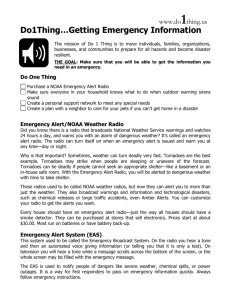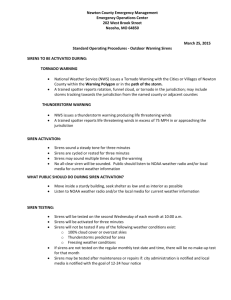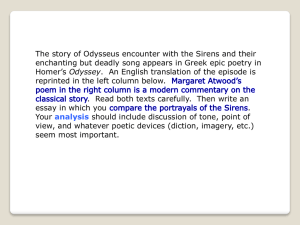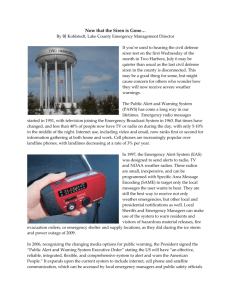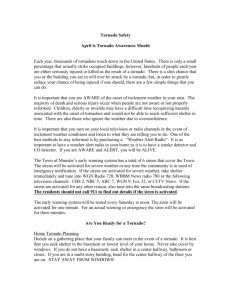Severe Weather Exercises Frequently Asked Questions
advertisement
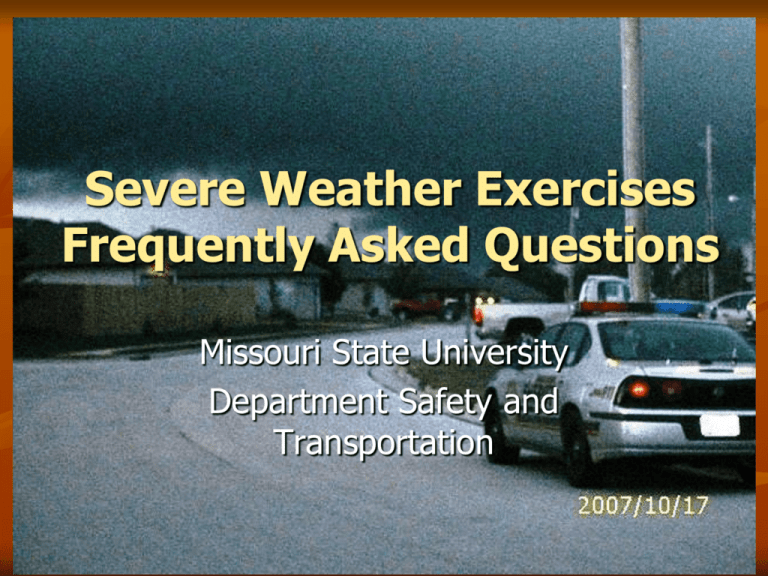
Severe Weather Exercises Frequently Asked Questions Missouri State University Department Safety and Transportation 1. Why does MSU conduct a severe storm exercise? Do we really need to participate? The threat of an actual severe storm on campus is VERY REAL. The likelihood of physical injuries or casualties ARE VERY REAL. Exercises are done to help those on campus to prepare for this dangerous threat. Yes. You should participate by learning where the shelter areas are in the buildings in which you will be. We suggest you do weather related “What if” scenarios. Ask yourself, “What WOULD I do if a tornado hit campus today?” 2. When are the storm exercises scheduled? The storm sirens are tested on the 2nd Wednesday of each month at 10:00 a.m. If inclement weather prevents the test, it is postponed to the following week. The State Emergency Management Agency in Jefferson City conducts an annual statewide severe weather exercise each March. The exact date is determined in January of each year. 3. Why are the sirens tested monthly? This is done to make sure the system is fully operational. If problems are identified, they are repaired as soon as possible. 4. Why does MSU have its own sirens when the city has them? The campus outdoor sirens handles the core of the campus while the city sirens are on the exterior boundaries of campus. One system naturally backs up the other when the other would fail to activate. On occasion, the campus siren system has actually and successfully provided back up the city’s sirens that have failed in the boundary areas. 5. When the sirens stop, does that mean the warning is over? No. Absolutely NOT! The outdoor sirens run a three minute cycle then shuts down to cool before re-activated again. 6. During the exercise and the siren stops, does that mean the exercise is over? No. The sirens run a three minute cycle. Continue with your evacuation to your place of safety. Once everyone is accounted for, you may be released by the building coordinator to return to your class. 7. The dining hall is full of people during the exercise time. What do we do? If a tornado hit at that moment, just WHAT WOULD YOU DO? This is the very reason we participate in these exercises, to help you prepare for such emergency. 8. Is it possible to extend the exercise? Continue with your evacuation to your place of safety. Once everyone is accounted for, you may be released by the building coordinator to return to your class or activity. 9. Why isn’t there an “all clear”? Normally, an “all clear” isn’t given due to the possibility of a second strike within a “watch area”. Persons that survived an initial tornado hit have been killed by an unsuspecting second tornado hit. Tornados are unpredictable in their travel paths. They can hit anywhere, at anytime. The NWS will sometimes broadcast the length of the warning. Many times, the warning length is extended due to remaining severe weather conditions in the watch area. As for the exercise, it continues until the building coordinator and their designees complete their tasks. This may take a couple of minutes or maybe fifteen minutes. When this is done, you may return to your class or other activities. 10. Why can’t we hear the outdoor sirens inside the buildings? The outdoor sirens ARE NOT designed to be heard inside the buildings. They’re intended to alert those outside to seek shelter immediately out of harms way. If the siren is sounding, there’s a very good chance, you’re going to know it in short time. How? Persons entering the building for shelter should be key reason for you to see what’s going on. Every effort has been made to place a Weather Alert Radio in each building where it can be monitored by the building coordinators and their staff. Building coordinators and their designees will be alerting occupants to seek shelter. You should make certain you are a part of a notification list. 11. Why don’t we have sirens INSIDE the buildings? Having active sirens in a building could have serious implications. Continuous or repetitive sounds such as a siren and or flashing lights could very likely trigger serious health problems (i.e. seizures, heart or anxiety attacks, etc.) or escalate potentially dangerous psychotic emotions in susceptible occupants which would increase the safety risk of others. Those persons having been alerted to the danger and moved to a place of safety, the inside siren would serve no other purpose. The siren could mask or camouflage noises from the storm or even the faint cry for help from someone injured by flying debris. Communication among the occupants would be difficult if they had to shout over a deafening siren. The less noise in a building or shelter area, the better. Silence is golden especially in the face of danger. 12. Who activates the storm warning system? Ultimately, the National Weather Service issues all weather statements for watches and warnings. While the threat of severe weather exists, our Communications Center in the Department of Public Safety closely monitors several weather information resources. This includes but not limited to, local law enforcement agencies, The Weather Channel, NWS Weather Alert Radio, local radar images via the internet, even the local radio and television stations. Once a warning is issued for our area, a weather statement is broadcast to those using the MSU trunked radio system. The outdoor sirens are then activated from the Public Safety Building at 636 E. Elm. We also utilize the Missouri State Alert System. It too will be activated through the Public Safety Communications Center. 13. Since we cannot hear the outdoor sirens, can we use the fire alarm speaker system for the alert? With the current fire control system, the answer would be “No”. Activating a fire alarm system in a building would have the opposite effect on the building occupants. A fire alarm is an alert for occupants to evacuate to a safe place outside the building. 14. What should I do if a warning is issued? Immediately seek shelter near you. 15. Are straight-line winds dangerous? Yes. Sometimes, they can be very dangerous and just as destructive and deadly as a tornado. When these dangerous winds are identified, the storm warning system will be activated. You should seek shelter immediately. 16. When should we leave the shelter area? During the exercise, the building coordinator will release you to return to your classes or activity after they have completed their portion of the exercise. During an actual WARNING, you should remain in the shelter until it’s SAFE to leave. Follow your building coordinator’s instructions. They’re working hard to keep occupants safe and informed of the status of the severe weather. This could take a few minutes to extended periods of time depending on weather conditions. Upon leaving, use caution and be prepared to return. 17. Our building has been damaged. The storm appears to have passed and all is calm. But we are asked to remain in the shelter longer than seems necessary, why? Buildings that suffer structural damage pose another whole set of problems. Caution should be used exiting the building as there may be strong winds with flying debris, lightning, downed power lines, jagged glass, broken gas lines, downed trees and other falling objects. Staying in place may be the best option until a SAFE ROUTE is established by rescuers. 18. What resources can we rely on for severe weather warnings? There are several resources to consider. Here are just a few: Local Radio and Television Stations. The Weather Channel NWS Weather Radio Outdoor Sirens Police Scanners Subscribe to the Missouri State Alert System located on Banner. 19. We need a Weather Alert Radio. Where can we get one? The NWS Weather Alert Radios can be purchased through the Department of Safety and Transportation at cost or through any local electronics dealer. Additional Information on Emergency Response and Evacuation Procedures The Emergency Response and Evacuation Plan establishes policies and procedures that will be employed when there exists the potential for an emergency condition, such as severe weather; an emergency situation has or is occurring; or in any situation where it is necessary and beneficial for the operations of MSU to be conducted out of a single location. In order to ensure the various plans at MSU will work in an emergency situation, MSU participates in drills and exercises that include campus personnel as well as local, county and state public safety agencies. Additional Information on Emergency Response and Evacuation Procedures The University has several procedures in place to communicate with faculty, staff, students and media regarding any emergency on campus and has established an emergency mass notification system known as the “Missouri State Alert”, on the Springfield and West Plains campuses. Complete details about the Emergency Response Plan and the Missouri State Alert System can be found at the following website address: http://www.missouristate.edu/safetran/erp.htm. Thank You For Your Participation
